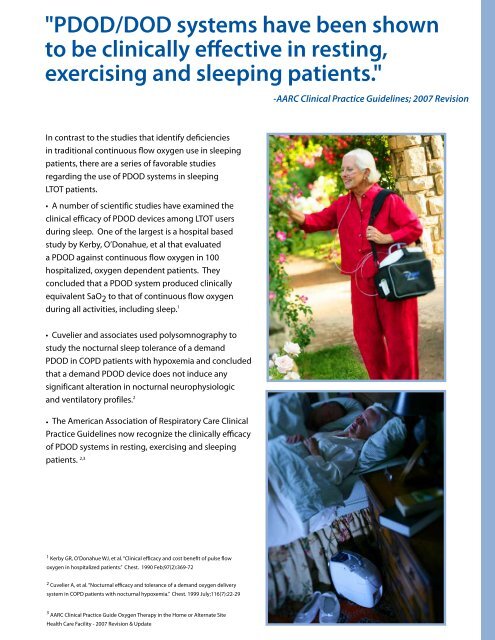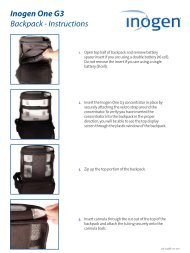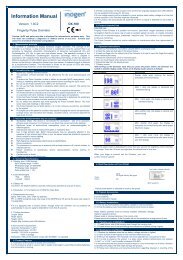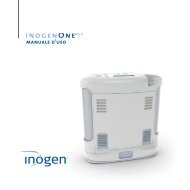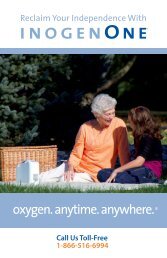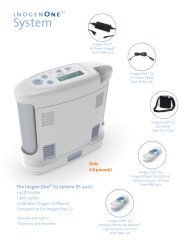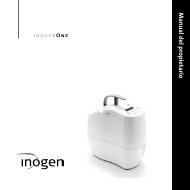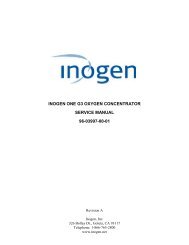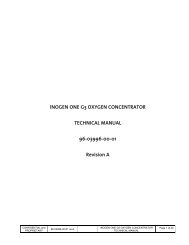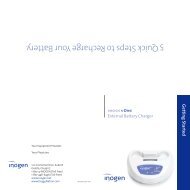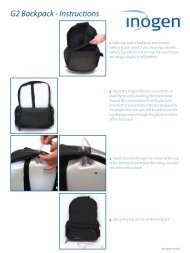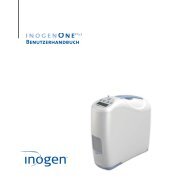Up to 50% of continuous flow oxygen therapy patients ... - Inogen One
Up to 50% of continuous flow oxygen therapy patients ... - Inogen One
Up to 50% of continuous flow oxygen therapy patients ... - Inogen One
Create successful ePaper yourself
Turn your PDF publications into a flip-book with our unique Google optimized e-Paper software.
"PDOD/DOD systems have been shown<br />
<strong>to</strong> be clinically effective in resting,<br />
exercising and sleeping <strong>patients</strong>."<br />
-AARC Clinical Practice Guidelines; 2007 Revision<br />
In contrast <strong>to</strong> the studies that identify deficiencies<br />
in traditional <strong>continuous</strong> <strong>flow</strong> <strong>oxygen</strong> use in sleeping<br />
<strong>patients</strong>, there are a series <strong>of</strong> favorable studies<br />
regarding the use <strong>of</strong> PDOD systems in sleeping<br />
LTOT <strong>patients</strong>.<br />
• A number <strong>of</strong> scientific studies have examined the<br />
clinical efficacy <strong>of</strong> PDOD devices among LTOT users<br />
during sleep. <strong>One</strong> <strong>of</strong> the largest is a hospital based<br />
study by Kerby, O’Donahue, et al that evaluated<br />
a PDOD against <strong>continuous</strong> <strong>flow</strong> <strong>oxygen</strong> in 100<br />
hospitalized, <strong>oxygen</strong> dependent <strong>patients</strong>. They<br />
concluded that a PDOD system produced clinically<br />
equivalent SaO 2 <strong>to</strong> that <strong>of</strong> <strong>continuous</strong> <strong>flow</strong> <strong>oxygen</strong><br />
during all activities, including sleep. 1<br />
• Cuvelier and associates used polysomnography <strong>to</strong><br />
study the nocturnal sleep <strong>to</strong>lerance <strong>of</strong> a demand<br />
PDOD in COPD <strong>patients</strong> with hypoxemia and concluded<br />
that a demand PDOD device does not induce any<br />
significant alteration in nocturnal neurophysiologic<br />
and ventila<strong>to</strong>ry pr<strong>of</strong>iles. 2<br />
• The American Association <strong>of</strong> Respira<strong>to</strong>ry Care Clinical<br />
Practice Guidelines now recognize the clinically efficacy<br />
<strong>of</strong> PDOD systems in resting, exercising and sleeping<br />
<strong>patients</strong>. 2,3<br />
1 Kerby GR, O’Donahue WJ, et al. “Clinical efficacy and cost benefit <strong>of</strong> pulse <strong>flow</strong><br />
<strong>oxygen</strong> in hospitalized <strong>patients</strong>.” Chest. 1990 Feb;97(2):369-72<br />
2 Cuvelier A, et al. “Nocturnal efficacy and <strong>to</strong>lerance <strong>of</strong> a demand <strong>oxygen</strong> delivery<br />
system in COPD <strong>patients</strong> with nocturnal hypoxemia.” Chest. 1999 July;116(7):22-29<br />
3 AARC Clinical Practice Guide Oxygen Therapy in the Home or Alternate Site<br />
Health Care Facility - 2007 Revision & <strong>Up</strong>date


